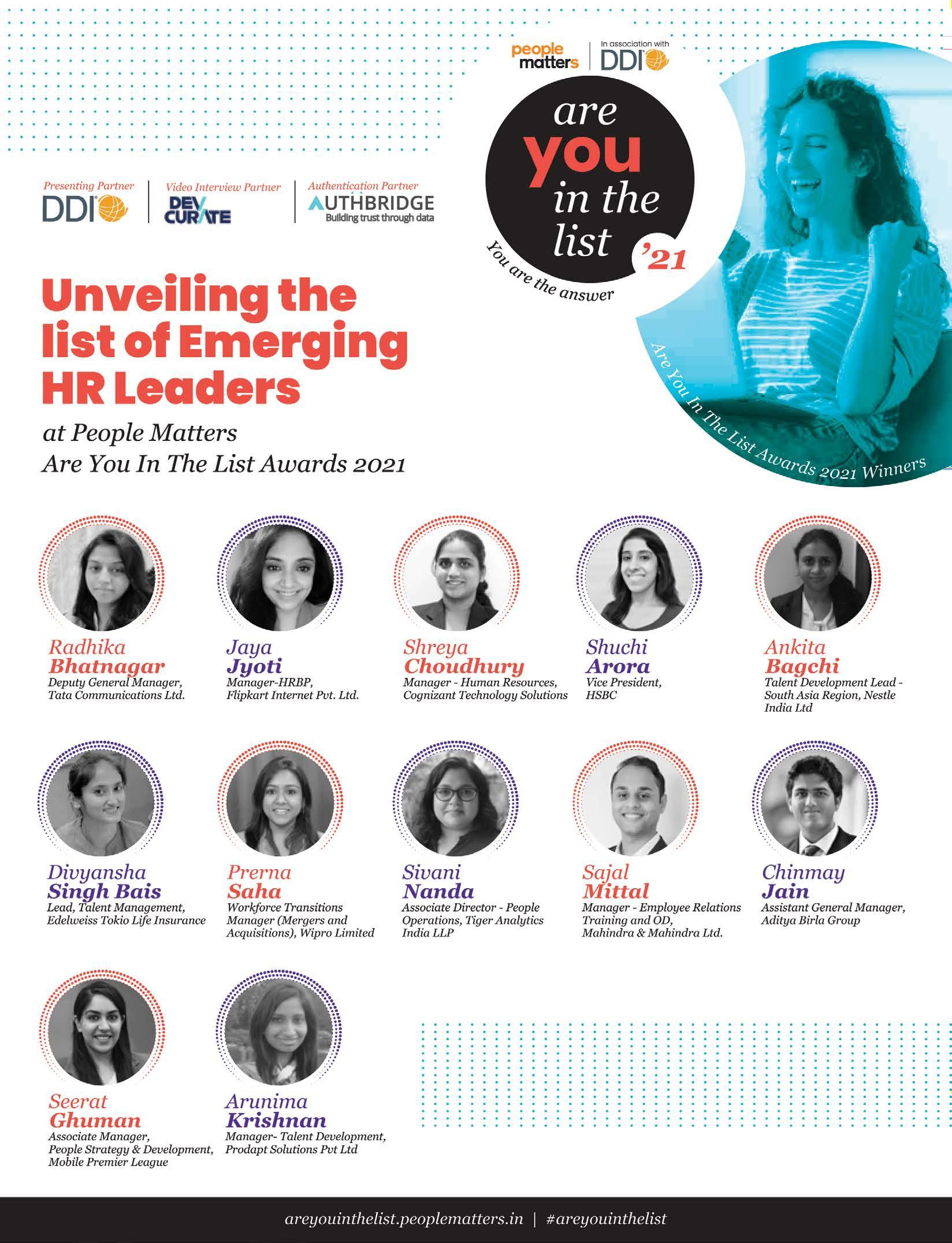
49 minute read
Solving the skills gap
Close to 70 per cent of employers globally are struggling to find skilled workers, especially in high-demand areas like operations and logistics, manufacturing and production, IT, sales, and marketing, according to a study by ManpowerGroup.
In that respect, 2021 is proving to be a great year. This year we have at least two new excuses for not having the talent we need – COVID-19 and digitisation. But, hang on!
Wasn’t it around 1965 that Moore advised us that the speed of digitisation would keep doubling? Wasn’t it in the 80s that we first learned about the war for talent? Wasn’t it in the 90s that we learned about the importance of engagement and retaining top talent? Wasn’t it in the 00s that we were warned that a pandemic was likely? Seems like we had enough advance notice!
And, guess what - things are unlikely to change for the better. For the foreseeable future, the speed of change will continue to generate demand for talent that outstrips supply. Only when the major global economies realise that continuous growth is not sustainable will that change and I wouldn’t even bet your money on that happening soon!
But, seriously, whilst there are clearly many specialist skills that do take years to acquire and master, most of the shortages are for skills that can be developed in-house, on-the-job, and often quickly. As with most business problems, we need to focus our attention on (a) the real issue and (b) what we can control. We simply have not taken skill development seriously enough. Staff development of all forms in many organisations is still spoken about as a priority and treated like a nice-to-do! We plough money into short-term hot topics such as “Diversity and Inclusion” and “How to work remotely” but fail to treat development as a strategic competitive advantage. If we are going to take the inevitable talent shortages seriously, there are four significant opportunities.
• Educate sooner - shift the focus in our education systems even more towards equipping young people to learn, practice, and advance new skills on their own, rather than merely filling their brains with the knowledge that they can access at the click of a button when they need it. develop “a” career; encouraged them to stay within a single discipline; encouraged them to view a career as (i) become competent, (ii) excel at it, and then (iii) manage others through that process.
Now, we need to equip and encourage individuals to view a career as creating a portfolio of experiences WHY - Understand (truly feel) why Self Development matters to you. WHAT - Make sure you know WHAT good and great really look like for you. WAY - Have a WAY of continuously managing your own development. WITH - ensure you have ongoing support (people and things) that will work WITH you to make development happen. WILL - Get your head straight - “I WILL take control of my own development and this is what I WILL do and achieve.”
Get your employees to apply those 5W’s and they will become happier, less stressed, and you will ease the talent shortages. Apply them yourself and you will become a more effective manager; a GOOD manager, perhaps even a GREAT manager. • Don’t promote individuals to people management positions as a reward for excelling at something else.
All too often organisations take their best person at doing “X” and promote them to managing others who do “X.” In the process, they lose an expert at doing “X” and gain a poor quality manager who demotivates those who are less good at doing “X.” And, we wonder why productivity has stagnated across large parts of the western world!
Whilst we have rapid and often free access to such vast amounts of information, evidence shows that accessibility and exhortation do not lead automatically to the acquisition of new skills. Hence, why we have to equip individuals at an early age with the skills, habits and discipline needed to take control of their own development. It’s too late by the time they enter the workforce. • In business, ensure that all employees from the second they join are trained, equipped, and encouraged to continuously develop their capability profile irrespective of their current roles.
For decades we have encouraged individuals to through which they have used existing skills to transition to a new role (that uses those and then adds new ones). We need to encourage them to become more adaptable and flexible. If COVID has taught us anything it is that the impossible is possible; that we can change the way we work quickly; that people are immensely adaptable and flexible when they need to be.
We need to ensure that all employees, from the first day with us, focus on their continuing professional development. This should be a key component of their performance expectations! The easy to understand and follow, 5Ws of the Personal Development process works effectively:
There are other options! Way back in the 70s organisations had “dual ladders” which enabled individuals to be promoted to more specialist roles without being given people to manage. Promotion should be a reward that is commensurate with the performance and aspirations to which it refers. Individuals should only be promoted into people-management positions if they have (a) shown informed interest in fulfilling such a role, and (b) demonstrated the competence, not merely some potential, to do so.
There are three reasons why this is important. First, it will demand that we train and develop individuals in management before their appointment. That will lead to a greater level of management skill available across organisations, which will improve decision making and operational performance generally. Individuals will also get a clearer understanding of the demands of management before deciding whether or not they want a full management role. Newly appointed managers will hit the ground running rather than learning from their mistakes.
Second, excellent managers continuously look ahead, make assessments of likely scenarios, conduct risk assessments, and plan accordingly. They don’t wait for the inevitable change to happen and then explain why they have been caught by surprise!
Third, excellent managers focus on ensuring that their staff develop, increase their capability, and become masters in their fields. That process in turn will retain top talent and become a beacon to attract new talent. • In business, ensure management excellence.
We have known since the 60s that many of our concepts of management had not worked, didn’t work, and would never work. Yet, we have continued to implement traditional processes with relatively few organisations truly testing their effectiveness or trying new approaches. As we explained in point 3 above, one seriously flawed process is that of promoting individuals and giving them people to manage simply because they excelled at something quite different. We have argued repeatedly that we have to stop that nonsense.
One good thing to come out of the combination of the pandemic and digitisation is that we have learned that sustainability demands excellence in management. I was delighted, earlier in September this year and during a People Analytics Summit, to witness Dawn Klinghoffer, VP or HR Business Insights with Microsoft saying, and I quote, ‘Exceptional People Managers are going to take us through this hybrid work situation we’ve been in and will continue to see.’ She went on to explain that their own research has identified this critical fact and they now have a Program Team focusing on Management Excellence … working towards only having people who WANT to be managers and who are trained and skilled to excel at it being promoted into people-management roles.
The unfortunate truth is that managing people simply isn’t simple, never was, and never will be. Trivialising it into mini-processes such as SMART Goal Setting, Giving Constructive Feedback,
Handling Conflict, etc does not help! Indeed, our own research has shown that all good people managers have at least a basic skill level in 52 competencies, clustered into four domains as defined by the Quaternion Profile[1]:
Leadership Creating a vision of the future, bringing it alive, and securing the commitment and resources to deliver it.
Management Optimising the use of resources to deliver the vision in line with the mission, strategy and values; making things happen. Personal Effectiveness Optimising personal contributions and impact.
Business Acumen Demonstrating the knowledge, skills and aptitude to operate in a complex and changing environment.
This also includes “Demonstrating functional expertise” which can be replaced and/or expanded to define functionally specific competencies.
Our own research has also shown that all good people managers know and understand the 7 elements in any performance management process, whether or not those elements were designed to be there (see the above graphic).
These elements, in turn, require a detailed understanding of what unleashes the inner motivations of employees and what crushes their engagement.
We must invest in the development of management excellence. It is not a nice-to-do, it is a critical need-to-do!
Will any of those four actions solve the Skill Gap? For some no. But for most, yes! And, at the same time, they will increase engagement, customer service, and productivity.
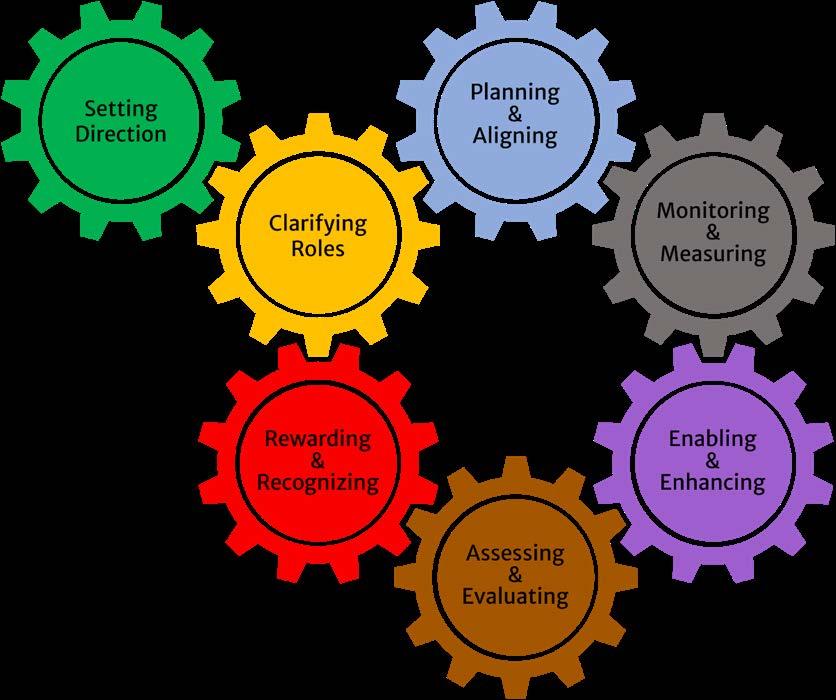
Leadership Creating a vision of the future, bringing it alive, and securing the commitment and resources to deliver it. Management Optimising the use of resources to deliver the vision in line with the mission, strategy and values; making things happen. Personal Effectiveness Optimising personal contributions and impact. Business Acumen Demonstrating the knowledge, skills and aptitude to operate in a complex and changing environment. This also includes “Demonstrating functional expertise” which can be replaced and/or expanded to define functionally specific competencies.
[1] A copy of the Quaternion Profile(R) is available on request from info@clintonhr.com
clinTon wingrovE is the Principal Consultant, Clinton HR Ltd www.clintonhr.com
A continuous skill gap analysis is a must to improve learner engagement: HR Director, Rackspace APJ
A technological shift is underway and more than any other economic or political cycle, this will dictate our labour market trends for the future, believes Shweta Mishra, Human Resources Director at Rackspace, Asia Pacific & Japan
by Shweta Modgil

Along with The Great Resignation, organizations are facing yet another challenge -- the skills gap conundrum. The shift towards digitisation and automation has distended the skills gap further forcing businesses to innovate their capabilitybuilding approaches in the new world of work. Close to 70 per cent of employers globally are struggling to find skilled workers, especially in high-demand areas like operations and logistics, manufacturing and production, IT, sales, and marketing, according to a study by ManpowerGroup.
On one hand, employees are forced to learn new skills to augment business transformations and grow their careers. On the other hand, this widening skills gap is one of the top challenges facing global leaders today. How are they fixing this gap?
In an exclusive interaction with us, Shweta Mishra, Human
Resources Director at Rackspace, Asia Pacific & Japan shared with us her skill transformation equation to prepare for the future.
Skill-building amid the continuing uncertainty comes with a lot of blockades. What are some of the challenges that you foresee in today’s environment?
The WEF has predicted that by 2022, a majority of Indian employees will require reskilling for the future. A lot of tech organizations have opened up their offices in India and some of the most in-demand skills would be AI, IoT, Blockchain, and Virtual Reality. So a technological shift is underway and more than any other economic or political cycle, this will dictate our labour market trends for the future. And that future is not very far off. This is the shift that organizations need to prepare for.
What are some of the challenges that you faced in the last 18 months when it comes to learning?
The main challenge for us was the virtual learning platform. We did not want our employees to get impacted while travelling to the office for an in-person learning opportunity. So moving our learning program to a completely virtual program has been a good challenge for us to tackle. But now we have moved into a complete virtual learning environment and enabled our employees to completely learn through online courses.

Learner engagement is the top area of improvement for virtual training in 2021, according to a study. How can organizations improve learner engagement?
The most important factor to drive engagement is that an organization should have a robust L&D team and resources. For instance, Rackspace has something called a Rackspace University-an internal website for employees for talent development. It focuses on global ways of working and engages our employees who we call Rackers. We offer state of art learning based opportunities to them. The learning and performance led team offers instructorled training, webinars, certifications in emerging technologies like cloud pace, AWS, Azure and the likes.
So I believe the companies need to have this kind of forum. We also partner with Linux Academy, LinkedIn Learning to enable our Rackers have a plethora of knowledge practice environments. So to drive learner engagement, a company needs to build internal resources and also tie-up with external resources.
What will be your one suggestion to organizations to improve learner engagement?
I think it’s a continuous skill gap analysis – how best we can analyze the gap in a particular environment or a particular country or a particular field or region. It cannot be a one size fits all approach. For instance, the

learning needs of our employees in the UK or US are very different from the needs of our employees in the APAC region. Even within APAC, the needs of Australian Rackers are very different from India Rackers. So you need to understand that and then fill the gaps accordingly. These again will be driven by the culture, role-based needs, and development opportunities available in a particular region.
Aligning the skills that workers want to imbibe in the postpandemic world with the most in-demand skills is huge in itself. How can organizations gauge the effectiveness of their learning programs?
We do a skill gap analysis very robustly and partner with our Rackspace University team that helps us design programs wherever needed. The mini-MBA that I was referring to above is the by-product of that skill gap analysis. We also do a lot of polls and surveys to ensure that we are providing the learning and development opportunities that employees want. That’s another way of understanding the skill gap analysis.
What will be your advice to fix the larger skills gap to prepare for the future?
Organizations need to understand that it’s not that there is a learning and development gap in the employees. It is more about upskilling them for future roles. Especially in the cloud and technology industry that we are in, there’s a whole lot of competition and a lot of new products come in that the employees need to be upskilled for. Apart from providing them support for upskilling, organizations need to focus on how they are retaining and rewarding their top performers and developing future leaders. So how do you enable your top performers to be future leaders is important.
What is going to be your learning priority for Rackspace employees in the coming months?
It will be a mix of both technical and soft skills. Soft skills have specially become important in a virtual environment - how are you communicating with people when you can’t see them physically or gauge what goes on culturally in their minds. This focus on soft skills will continue post the pandemic when we start travelling and meeting people in person. And of course, upskilling in terms of a competitive market is a must to retain our top talent.

Can Hybrid Model be better for boards?
While the businesses open boardroom doors after eighteen months, there is a realisation that not all individuals need to be on the site. As the remote workforce has absorbed the innovations more efficiently than what leaders imagined at the initial stage, the leaders may choose to adopt hybrid boardroom meetings depending on several factors by dr. M Muneer & Ralph Ward
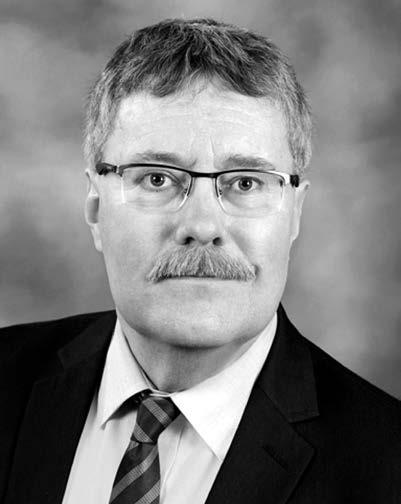
As businesses are limping back to some cautious normalcy even as a third wave is on the anvil, many executives have started to make the travels that have been missing in their work lives. This has rekindled the plans for the board of directors to resume the physical meetings even though the virtual ones were much more efficient in terms of costs and time.
Almost 18 months after the first lockdown, many companies are unlocking the boardroom doors and weighing if, when and how to get back to in-person meetings. We have learnt many lessons on how much boards can do remotely (far more than we thought possible two years ago). There is still a human need to connect, for unstructured chats, give-and-take, and personal nuance that Zoom images really don’t deliver.
Many of us know that a full return to the boardroom, just like the good old days, remains far off. That means an in-between alternative – hybrid board meetings with some attendees at headquarters, and some still remote – is the next step in governance.
The move to all virtual, online governance was a sudden fait accompli. None of us had a choice, and we had to make it work. Improvisation, missteps and oversights were the rules for early virtual board meetings, but it was that or nothing – and “nothing” governance would never be acceptable to regulators or investors.
The move to hybrid board meet-
ings is more gradual and voluntary, yet more uncertain. How do you decide when to return to in-person meetings? Who can still stay remote, who shows up in the boardroom, and how do you take that decision? Is unwillingness to travel an acceptable excuse from a director? Will you stick with virtual board committee meetings for a while? And, are you returning to the boardroom for better governance or because some members prefer it?
When you locked down your boardrooms back in early 2020, everyone accepted some miscues and fumbles in governance would happen. Now, board oversights will lose their COVID “shield”. If some directors end up better informed than others, or a major board decision is fumbled between the “in and out” members, there will be no excuse. You chose to go back with hybrid meetings -- and now must prove that they will make your governance better.
Here are a few basic issues your board can address before going to a hybrid model: • Make your return-to-the-boardroom call with willingness to turn your default board meeting ideas on their heads. The first question shouldn’t be
“can we go back to some live governance yet,” but rather
“why shouldn’t we stick with everyone on the board meeting remotely?” What specifics can you improve by having at least some board members and staffers together at company headquarters, instead of what you’re doing now? There are legitimate answers to this. Sometimes staff presentations work better with an on-site team approach.
Strategy deep dives and new board member interviews are being done virtually, but an in-person group improves depth and logistics. Realise your board can do more online than you thought a year ago, but in-person still has advantages. • Who will stick to remote, who will convene in your boardroom, and why the decision?
Your management team has been working its way back into the office lately though debates over this have grown wider.
This means that the CEO, CFO, and various other top manag-
ers are the ones most likely to be dusting off the boardroom, with independent outside directors joining virtually. This also makes an independent board chair/lead director neither fish nor fowl – still remote, but expected to be on site. Anecdotal evidence suggests CEOs are the ones pushing workers to return, and that they extend that view to their board members too.
This is the moment when independent board leadership needs to step up and act as a sensitive negotiator among the various views of the chief, other staffers, and outside directors.
There are doubtless shifting, but often strong, views among board members on returning to the boardroom, and the effective leader should serve as an honest mediator. • Assuming you have a consensus that yes, your board will meet with some members in the boardroom, move on to asking how it can work best. Corporate boards have always seen outside independent members a step behind the management members who are immersed in the company on daily basis.
Board meetings with a huddle of the CEO and top managers onsite and everyone else on their distant Webex screens aggravate this mismatch.
When deciding on a hybrid board meeting, it may be wise to assume that all Insiders on the inside and outsiders on the outside, but it still isn’t good enough. Until you can convince a few independent directors to fly in and create boardroom
balance, maybe you should stick with everyone online. • Don’t base your video, audio, presentations, portal resources and so on solely upon their convenience and practicality. The easiest hybrid format might not be the best. The assumption that having some directors together at home base and the rest remote automatically creates an “in” group and an “out” group twotier board. The “in” group gets to chat in advance, plan out their agendas and responses, and exchange knowing glances in the meeting, while the “remote” group feels like second-class citizens. Measure every element of your hybrid board plan and tech by how well it counters this, and be willing to make life a little more difficult for those in the boardroom if it levels the playing field.

MunEEr is co-founder of the non-profit Medici Institute and a stakeholder in the Silicon Valleybased deep-tech enterprise Rezonent Corp. ralPH is a global board advisor, coach and publisher. Twitter @MuneerMuh
viSty BAnAji
Culture change is not a screw-on job
Visty Banaji adds a coda to Peter Drucker’s aphorism: "Culture eats strategy for breakfast … and still has the appetite to devour an upstart, invasive, new culture imposed on it, for elevenses"
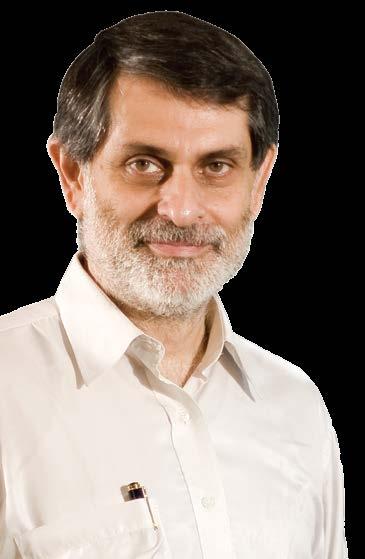

There is a virus stalking corporate India. It is not as immediately lethal as COVID-19 though, like all viruses, it is parasitical and does nothing for the survival-fitness of the host. All it takes is for a primary nerve centre (usually a newly appointed CEO or CHRO) to have a few suitably configured entry receptors for the roving virus to latch on. Once that happens, other immunological defenses (meant to be overseen by HR) prove to be of no use and, in fact, become carriers for strange new memetic sequences which they attempt to graft onto the existing DNA of the organization.
The virus is called Culturechanguenza Vulgaris in its most common variant and CEOs, HR Heads and other CXOs eager to show their shine are particularly prone to getting infected. Especially during their first 100 days in a new job, they are likely to let down their minimal skeptical guard1 and look for quick fixes that can amplify their auras. Initiating a culture change programme seems to be an extremely attractive option at such times. For the 'consultagion' too, this defenses-down time is the best occasion to strike. After all culture change projects are among the most lucrative ones consultants can land. The effort : return ratio for culture change work is incredibly low and even Planck’s Chauffeur2 can be assigned to the job. A mature HR function, with a strategically integrated transformation programme underway, should be in a position to counter such an individually-motivated incursion. Obviously, this is easier said than done when the receptor cell for the virus is placed atop the head of a new CEO or CHRO. Rutger Bregman captures the undesirable consequences of criticizing the boss-man through the ages: "Just try standing up to a strongman who has all opposition skinned, burned alive,
or drawn and quartered. Your criticism won’t seem so urgent."3
Of course, the demand for cultural change isn’t as irrational as I have made it sound. Study after study has shown that certain cultural standouts make significant contributions to organizational performance in specific industries and environments.4 The problems start when an idée fixe in the CEO’s head or the consultant’s toolkit is considered the cure-all for all organizations, regardless of the historical heritage from which they are coming or the strategic direction in which they are headed. Problems caused by generic culture change directions are hugely compounded when results are demanded and promised in short time-spans which, on the scale of time taken by true cultural change, are mere eyeblinks. Another potential cause for the failure of ill-considered culture change is the manner in which full range consulting firms staff such mushy projects. Since outcomes are hard to measure, it is tempting to assign to them the callowest consultants who have never experienced the thrill of working in an organization with a vibrant culture (case studies can capture it as well as an infantry manual holds the secrets of battlefield brotherhood). The irreverent glee with which these infants dismantle a treasured culture and substitute reminted, MAA (Motherhood And Applepie) phrases in its place, raises a wall of resentment which puts paid to any slight chances of cultural transformation actually materializing.
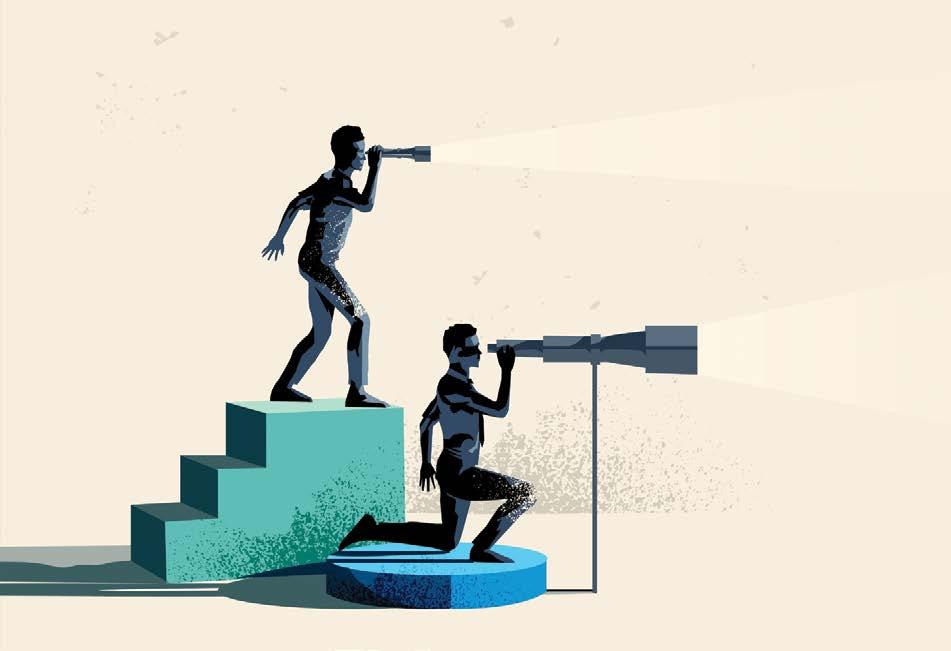
The spirit of the enterprise
I am far from being the first one to suggest vectoral maxima and temporal minima for cultural change. Montesquieu, writing in the 18th century, had similar concerns in mind while cautioning over-ambitious lawmakers. "… [A]s a society develops, the moral causes acquire an increasing purchase on a society’s esprit général [the moral, social and political culture of a given society]. The esprit général of a society, whether it is simple or sophisticated, is the legislator’s raw material, so to speak. He legislates against it at his peril, and at the peril of the whole of that society. At best, laws enacted against the esprit général will simply fail to work; at worst, if vigor-
ously enforced, they could destroy the society which the laws are meant to preserve… Sometimes a legislator might be tempted to legislate against the grain of the whole of a society’s life, and Montesquieu believes that in cases like that "… [t] he legislation will fail, and the system of government which produced the legislation might well fall with it... The very complexity of the esprit général gives the wise legislator plenty of room for manoeuvre within it, and there is plenty of opportunity for reform within it."5
Montesquieu’s own words sound strangely modern when he advises policies be tailored to culture (rather than the other way around as is expected to happen, for example, when a new CEO brings in policies from his previous firm and expects the receiving culture to adopt them): "… [T]he government most in conformity with nature is the one whose particular arrangement best relates to the disposition of the people for whom it is established… Laws should be so appropriate to the people for whom they are made that it is very unlikely that the laws of one nation can suit another..."6
How does the culture plant grow?
Can we couch the same principles using current corporate terminology and back them up with recent research? Indeed, we can.
Let’s first define culture in the context of today’s business context. Definitions abound but here’s a perfectly acceptable one: "Culture is the tacit social order of an organization: It shapes attitudes and behaviors in wide-ranging and durable ways. Cultural norms define what is encouraged, discouraged, accepted, or rejected within a group. When properly aligned with personal values, drives, and needs, culture can unleash tremendous amounts of energy toward a shared purpose and foster an organization’s capacity to thrive. Culture can also evolve flexibly and autonomously in response to changing opportunities and demands. Whereas strategy is typically determined by the C-suite, culture can fluidly blend the intentions of top leaders with the knowledge and experiences of frontline employees."7
To my reckoning, organizational culture has three vital components which go a long way to explaining why changing it takes so much time and invites such opposition. To start with, culture is founded on shared history. It is not important how true that history is, as long as it is believed with passion. The corporate history that grounds its culture is replete with heroes, villains and deeds of sacrifice and infamy. There are breathtaking tales of life-threatening dangers and how they were overcome. The narratives hold morals which can either bolster or belie the values the company officially blazons. From this historical memory flows the second ingredient of a strong culture: the people, actions and things that are respected and revered (to the point of

sacralization) and those that are reviled. The history and reliquary join together with the tacit instructions (usually imparted by way of example) that old-timers impart to an incoming generation for creating the third part of the cultural tripod. This consists of the initiatives taken and reactions given by people when there is no specific instruction from a senior or set procedure governing conduct. With sufficient repetition these actions become more than habits – they become the ineffable codes of appropriate behaviour pervading the organization. these, the effort would be fruitless. To the extent the new directives belittle or contradict the characters and codes solidified into legend over years, the best outcome can be that the new instructions will be ignored. Pushed too far and too fast, however, and the change effort can elicit a reaction as belligerent (even if kept unrevealed) as that from a true believer forced to apostatize. Not that a few toadies won’t start sprouting the new Decalogue. But this will just solidify the resentment of the rest. Creating a new history (which, hopefully, yields a new set of legends terprises. How then can one improve the odds in effecting it?
If change is essential in the way things are done, there are a variety of devices that are at our disposal. Cultural transformation is not the first tool we should pick up. It should be close to the last attempted intervention, after examining and, in some circumstances, trying what can be achieved through changing people, processes and even structures. Montesquieu’s wisdom is worth repeating after all these years: "With regard to mores, much is to be gained by keeping the old customs… [R]ecalling men to the old maxims usually returns them to virtue."6
After careful consideration and conversation, should cultural change be identified as the appropriate intervention, there are two directional blunders that need to be avoided. Regardless of the supposedly irrefutable empirical evidence the 'consultagion' presents, do not get carried away by the specific snake-oil s/he is peddling or the fad of the day, both of which can frequently be the same. Seemingly more grounded is a culture change target, specifically derived from your strategy and tailored to your needs. However, if it is diametrically opposed to everything the company has stood for so far, you need to think long and hard before aiming for it. And at the end
It should now be obvious why changing the culture is a lot more complicated and time-taking than just changing a few senior people and operating protocols. Taking the points from the previous paragraph in reverse order, the actions that determine culture are not in written manuals or supervisory instructions. Even if someone were to undertake the nearimpossible task of codifying and commandments) takes time and time is precisely what those infected with Culturechanguenza Vulgaris don’t have.
True transformation
Even a great conservative like Edmund Burke maintained that "[a] state without the means of some change, is without the means of its own conservation.”8 This is equally true of business en-
of that thinking process, you probably need to find a bridge less far.
It is worth understanding this ambition-dampener in some detail. To do so we need to use a typology of the corporate culture. There are a number of such models which are used for both diagnostics, inter-unit comparison and change targeting. Denison’s model9 as well as the one proposed by Cameron and Quinn10 have great intuitive appeal and have been used by many or4. Enjoyment is expressed through fun and excitement 5. Results is characterized by achievement and winning 6. Authority is defined by strength, decisiveness, and boldness 7. Safety is defined by planning, caution, and preparedness 8. Order is focused on respect, structure, and shared norms
These are fitted into an integrated culture framework
To my reckoning, organizational culture has three vital components which go a long way to explaining why changing it takes so much time and invites such opposition. To start with, culture is founded on shared history. It is not important how true that history is, as long as it is believed with passion
ganizations. So has the one described by Groysberg (and others)7 and I will use it for our illustration. According to Groysberg, there are eight types of company culture. These are: 1. Caring focuses on relationships and mutual trust 2. Purpose is exemplified by idealism and altruism 3. Learning is characterized by exploration, expansiveness, and creativity according to the degree to which they reflect independence or interdependence (people interactions) and flexibility or stability (response to change). "Each style has advantages and disadvantages, and no style is inherently better than another."7 For our present purpose, the key is that the more distant a targeted culture is from the existing one on the grid, the greater the effort needing to be expended, resistance to be overcome and time demanded.
Excessive force, urgency and ridiculing 'the old way' can certainly BREAK the existing culture. Equally certainly, heavy-handed haste and humiliation of heritageholders cannot MAKE a successful culture to replace the earlier one.
Let us look at an example of an immense cultural transformation that worked. I got it directly from a friend who is among the most successful stars on India’s HR horizon. Though he, in a true partnership with his boss, was responsible for the recast, he still shies away from taking credit for it and, hence, remains unnamed here. Though the actual plan may vary from case to case, I would be surprised if more than one of the five principles I have gleaned from this case were missing in any successful cultural transformation: 1. Be aware of the pride attached to traditions of the organization and the culture that has brought it success in the past.
Respect it sincerely and leverage it (see 3 below) to support the transformation. Never trash the existing culture and deal severely with over-eager transforming crusaders who do so 2. As far as possible, avoid announcing a grand plan of change. Whenever a glimpse of the path has to be provided,
stress its continuity with the past and explain why a redirection is essential. Preferably put the burden of the explanation on external causes – rather than point a finger at failure within. 3. Effect the change element by element, incrementally. Moor explanations to the core values cherished by the organization. Sometimes simple activities (an awards event, a new training format or even a redesigned application form) can profoundly alter the cultural tone without openly declaring such an intent.
Constantly experiment and do not hesitate to withdraw. A tactical retreat is perfectly feasible when each element is only one out of many indirect steps to reach the main objective. 4. Have patience. In the mega-conglomerate we are discussing, without much fanfare and
trumpeting, the organization’s culture was substantially different (bar a few core principles) in a decade. Please note the time span. The next ten years took the transformation still further and, more importantly, consolidated and embedded the new culture i.e. gave the new culture its own history, heroes and legends. 5. Don’t position yourself (even if you are the
CEO and certainly not if you are the CHRO) as the saviour coming to the rescue of a rotten operation from fools and villains. If you are truly successful, fame will find you.
Notes
1. Visty Banaji, Pyrrho, please pay another visit - A DIY kit for sniffing out BS in HR,
People Matters, 23 March 2017, (https:// www.peoplematters.in/article/strategichr/pyrrho-please-pay-another-visit-a-diykit-for-sniffing-out-bs-in-hr-15175). 2. From Charlie Munger’s 2007 USC Law
School Commencement Address where he said: 3. "I frequently tell the story of Max Planck, when he won the Nobel prize and went around Germany giving lectures on quantum mechanics. And the chauffeur gradually memorized the lecture and he said, 'Would you mind, professor Planck, just because it's so boring staying in our routines, would you mind if I gave the lecture this time and you just sat in front with my chauffeur's hat?' And Planck said, 'Sure.'
And the chauffeur got up and he gave this long lecture on quantum mechanics, after which a physics professor stood up in the rear and asked a perfectly ghastly question.
And the chauffeur said, 'Well, I'm surprised that in an advanced city like Munich I get such an elementary question. I'm going to ask my chauffeur to reply.' " 4. Rutger Bregman, Humankind: A Hopeful
History, Bloomsbury Publishing, 2020. 5. Daniel R Denison and Aneil K Mishra, Toward a Theory of Organizational Culture and Effectiveness, Organization Science 6(2), April 1995. 6. J S McClelland, A History of Western
Political Thought, Routledge 1996. 7. Charles de Montesquieu, Editors: Anne M
Cohler, Basia Carolyn Miller and Harold
A vaccine is not a cure
It is important to emphasize that the foregoing was not a blueprint for actually managing a cultural transformation programme. That would have required at least an entire book to itself. We have simply touched on a few essentials to be observed before embarking on such a programme and during it.
This column should inoculate you against an attack of Culturechanguenza Vulgaris for at least the next twelve months. No vaccine is 100% effective but this one should protect you (and your incoming CEO) against most strains of the virus. "But", I hear you say, "my CEO has already launched the exercise and paid a crazy advance to some fast-talking 'consultagions'. Should I show him this article?" That, dear friend, would be a career-shortening move. Administering a vaccine after the onset of the disease can have dire consequences. At this stage the best you do is go along for the ride and hope only superficial damage is done before a premature 'Mission Accomplished' is announced.
visTy Banaji is the Founder and CEO of Banner Global Consulting (BGC)
Samuel Stone, The Spirit of the Laws (Cambridge Texts in the History of Political Thought), Cambridge University Press, 1989. 8. Boris Groysberg, Jeremiah Lee, Jesse Price and J Yo-Jud Cheng, The Leader’s Guide to Corporate Culture, Harvard Business
Review, Juan-Feb 2018. 9. Edmund Burke, Reflections on the Revolution in France, Penguin,1968. 10. Daniel R Denison, S Haaland, and P Goelzer, Corporate Culture and Organizational
Effectiveness: Is Asia Different From the
Rest of the World? , Organizational Dynamics, Vol. 33, No. 1, pp. 98-109, 2004. 11. Kim S Cameron and Robert E Quinn,
Diagnosing and Changing Organizational
Culture: Based on the Competing Values
Framework, Jossey-Bass, 2011.
Past Month's events
Recrafting employee experience for the Indian IT Industry
People Matters &
Randstad 29th Sept 2021 Online In today's world of work, what it means to be an employee has changed. Candidates for a job are looking not just at the work and the pay, but at the entire experience of working for the organisation: the leadership style, the growth and development opportunities. But are companies matching these expectations? Not many would agree. In this panel discussion, Randstad India in association with People Matters discussed how leaders from the IT industry can recraft the employee experience journey in the new world of work.
People Matters EX APAC Virtual Conference
People Matters 9th Sept 2021 Online People Matters EX APAC Virtual conference was a full-day event that featured four virtual tracks and deepdived into different aspects of the EX with keynotes, case study sessions, panel discussions, and dedicated virtual exhibition space for service providers to showcase their latest offerings. We successfully hosted it with over 1,300 delegates and explored how EX translates in every decision in the talent strategy. Skillsoft Perspectives 2021
Skillsoft 22-23 Sept 2021 Online If we’ve learned anything in the past year, it’s that change is the only thing we can count on. And — more importantly — that learning is the single best way to make sure that you and your workforce are ready. Ready to adapt. Ready to grow. Ready for whatever comes next. Perspectives Unleashed 2021 focused on the following topics and themes: From Skills Gap to Skills Revolution: Transforming Today’s Workforce for Tomorrow’s Economy | Who Owns the Skilling Agenda? | If the Future of Work is Now – What Now – is the Future?
Moving from Disruption to Strategy: A blueprint for the next 3 years in EX
Qualtrics 7th Sept 2021 Online To maximise the success of the experience transformations underway in every workplace right now, it’s critical HR and people leaders align their programs with business priorities. This will help demonstrate the full impact of the work undertaken to ensure HR maintains its critical position at the leadership table. The series of masterclasses discussed best practices based on proven examples of how other organisations are designing and improving their EX programme as they look to the new normal. Futurist Forum - A Masterclass on Architecting the Future of Work
People Matters 17th Sept 2021 Online This masterclass with Dave Ulrich, Co-Founder & Principal, The RBL Group was designed for top CHROs. It delved deeper to help talent leaders equip themselves with strategies, skills, and tools so they can rise to the opportunity and help drive the larger business transformation.
People Matters Are you in the List Awards
People Matters 3rd Sept 2021 Online As HR leaders played a pivotal role in spearheading their organisations through the uncertainty, stress, and change, they developed and defined a new core set of skills which is going to be a prerequisite of emerging HR leaders in the second year of the pandemic and beyond. It is these very visionary and talented HR leaders that the People Matters Are you in the List 2021 Awards which is in its 10th year of running aimed to recognise - the new generation of HR leaders who rose to the challenge of 2020 and became the answer to the challenges in the People and work space and have redefined HR for the future HR leaders.
Upcoming events
Women in Leadership: Lead, Influence & Transform Reinventing learning: Fueling a training model where employees own their skills Designing Employee Experience in a Hybrid world
People Matters
BeNext 4th Oct - 5th Nov 2021 Online This programme is designed for women leaders interested in accelerating their career growth within their organisation and learning critical skills for women heading a team. It will help them overcome obstacles facing workplace gender imbalance and speed up the realisation of their potential as a woman leader. People Matters &
Degreed 5th Oct 2021 Online While over two-thirds of companies see the trend of learning experience as urgent or important, only 5% believe they have mastered the content and technology capabilities needed to make online learning an accessible tool and a compelling experience. In this virtual session by People Matters and Degreed, we will look at how by empowering employees to become equal partners in the learning process, HR organisations can foster a culture of development and growth — driving performance, engagement, and career development. People Matters
BeNext 11th Oct - 12th Nov 2021 Online This programme is for employers looking to reshape EX for their teams in the new remote environment of the working world. We will explore key considerations for designing an impactful, outstanding employee experience that aligns with our new hybrid reality.
Design Thinking & Agile for HR Teams
People Matters
BeNext 22nd Nov - 24th Dec 2021 Online This programme is for HR leaders committed to finding creative solutions to complex problems facing their teams, moving from a foundational understanding of Design Thinking and Agile methodologies to a whole new mindset of creativity, innovation and people-centered progress. We will uncover creative practices and seek solutions for complex HR problems through the prism of Design Thinking & Agile methodologies. Diversity and Inclusion: Overcoming Unconscious Bias
People Matters
BeNext 15th Nov - 17th Dec 2021 Online This programme is for leaders invested in creating lasting mindset shifts and creating the foundations of a psychologically safe organisation through the implementation of impactful D&I initiatives. We will overcome unconscious bias at all levels to create a work context where everyone is valued, respected and included. People Matters L&D Conference 2021
People Matters 21st Oct 2021 Online What should the evolving learning agenda for the next normal look like? What are those learning objectives that organisations should be absolutely clear about even if the future looks a bit ambiguous at this point? What are those tools that can help organisations evolve their capability agenda faster? And most importantly, what are the challenges you need to be aware of, on the way to this evolution? People Matters L&D Annual Conference 2021 will discuss our community's questions to help us reflect and find collective answers.
BOOK REVIEW: ‘DECODING PEOPLE’S PULSE’
The book ‘Decoding People’s Pulse’ by Paul James, a wellknown HR professional, is all about how HR can partner with people to create impactful experiences and reimagine the approach to designing surveys for driving performance

by R. venkatanarayanan

How to decipher and decode employee experience? How do we align with the changing requirements of a diverse workforce and craft meaningful policies?
The book ‘Decoding People’s Pulse’ leads you to the answers to such questions. The book is a sharing of experiences by Paul James (PJ), a well-known HR Professional, with over 30 years of industrial experience. It is not merely that, but it also traces the origin of his thoughts while he was working as Head HR at Thirumalai Chemicals in understanding what made highly involved, intrinsically driven technical workforce either stay or leave the company. Paul has taken the road less travelled by HR professionals by undertaking a survey research to arrive at interesting conclusions instead of working on assumptions.
This book was released recently on 18th September 2021 at a ceremony in Chennai by M. Raj Kalyanarajan, Senior Director of PCA Automobiles India Pvt Ltd., of the newly setup car major Stellantis Group at Thiruvallur, Chennai.
Also in attendance were R. Venkatanarayanan, President HR & IT of Rane Holdings; A. Thirunavukkarasu, CHRO Hatsun Agro Products Ltd;.P.N. Rajendran, Executive Vice President of Yokohama Tires; Sampathkumar, Vice President Fives India Engg & Projects Ltd., Mrs. Hannah Paul, Head HR of CMC&H; Raju Elangovan, MD E-merge; Amaladoss,Director HR, TEMPEL Precision Metal Products India Private Limited; Prasanna Padmanaban, Vice President, Barclays Global Service Centre;
Senthil R, Head – HR & IR, Yokohama Tires; E.I.R.Ravindranath, Advisor HR; Anbarasu, Retd. Head HR of SRF; K.S Ravikumar, Legal Head of Asahi Glass; Thendral Mani MD, BETeam; Ramesh Kannan, Sr.Manager HR, Flex; K.S.Sivakumar, Sr.Manager HR, Reynolds Pens, Damodaran DGM-HR of Kosei Minda; Jeyabarathi Opns Head Tiger Analytics; Ramnath,GM HR Rane NSK;Shankar of Maven; Valentina Balagopal, Jonathan Samuel, Karen Jonathan, Eugene Thangaraj, and Josline Nikhita from PSCS Analytics and Vignesh, Asst. Manager HR of TCS.
On the release, Raj Kalyanarajan stated, “I am delighted to release the book written by PJ. I got acquainted with PJ when I was engaged as an IR Advisor when PCA took over operations in Thiruvallur. I never realized that PJ had the expertise in HR and specifically Organizational Behaviour, which incidentally is an area of interest to me as well though not to the depth that of PJ.” Kalyanarajan further added that the book talks about organizational behaviour, the human mind, about making connections between workforce commitment and intrinsic and extrinsic rewards. But the specialty is that it draws connection to the influence of family towards satisfaction (fulfillment). This is customizing to the Indian context as culture plays a big role in how all of us behave. Work life balance matters as without engagement at home, one cannot expect an employee to be engaged at work. The book offers several in-depth analyses on what factors contribute to the way people are and how they can be supported in transitioning from being disconnected or disassociated people to a highly involved and connected or passionate workforce

Supporting people to become passionate employees
‘Decoding People’s Pulse’ is all about how HR can partner with people to create impactful experiences. Tracing the journey of a HR professional passionate about research, the book gives its readers a ready to relate OD model.
high This OD model differs from others in the sense that it is contextually relevant and makes business sense.
Further the book offers several in-depth analyses on what factors contribute to the way people are and how they can be supported in transitioning from being disconnected or disassociated people to a highly involved and connected or passionate workforce.
Later, this book tells us about how Paul could prepare this as a product and support major companies in understanding employees’ climate. The work is a result of hard work ably supported by his longtime friend Dr, V.S.R.Vijayakumar Rtd Professor of OB from IMT Nagpur.
This book differentiates his product viz., PSCS-ESS from the major service providers in this field and shows by rigorous statistical analysis that it is a reliable product to use. The PSCS-ESS survey helps to understand the workforce in terms of a quadrant arrived at using satisfaction and commitment as shown below.
Being a successful HR professional, Paul believes that the model proposed by him is an OD model which will help organizations to plan long-term strategies after identifying the workforce as explained in the figure aboveassuaged, passionate, disassociated, or pledged.
This is a handy book for all HR professionals who are keen on making a difference in the workplace in the form of thought through action plans backed by reflective data. Moreover, it is industry and experience agnostic.
In conclusion, Paul has beautifully presented the linkage of various factors that impact people that are insightful and will be of immense value to the readers. One could take a leaf out of PJ’s book to enhance workplace culture.
js ) s atisfaction ( j ob
low
low
c - type high - js low - c
assuaged
Disassociated low - js low - c
d - type A - type high - js high - c Passionate
Pledged low - js high - c
B - type
organizational commitment (c)
high P.S: PSCS-ESS surveys have been carried out in reputed companies such as Delphi-TVS Diesel Systems Ltd., Siemens Building Technologies, Vedanta Aluminium Plant at Lanjigarh, L&T (RPM) JSW Salem, Apollo Tyres, Siemens Gamesa,ATC Tires, Sharda Motors, Omax Auto, Reynolds Pens, etc. This survey was also carried out in Thirumalai Mission Hospital and Thirumalai Charity Trust. PSCS not only takes up PSCS-ESS which is its main plank but also conducts surveys for assessing CSR Projects, Assessing IR Climate in industries and Places, Stress, etc.
r. vEnkaTanarayanan is the President HR & IT & Rane Holdings
Blogosphere >> craig w. ross
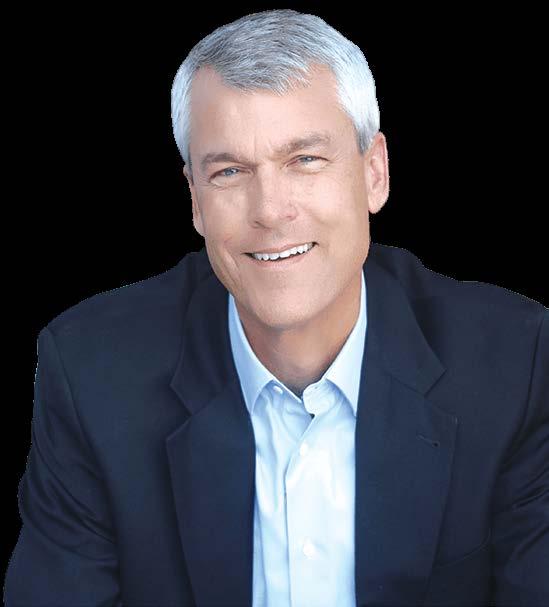
The 5 disciplines of collaborative leadership
Anthony was in trouble: because of his success in leading a large R&D team within his organisation, he was now tasked with leading an enterprise-wide digital transformation initiative. ‘I’ve been able to lead my direct reports effectively, but this,’ Anthony hesitated, ‘this will require influencing and aligning people over whom I have no authority.’
It was a defining moment of leadership for Anthony. Leading a digital transformation requires aligning cross-functional teams, often with a workforce that is geographically dispersed. Could he successfully guide employees in collaborating across the enterprise?
According to researchers, most leaders fail to meet this defining moment. A relevant study highlighted the inability of colleagues to collaborate effectively. When 80 senior executives from 20 countries and 25 industries were asked what the biggest barriers to long-term strategic execution was, over 76 per cent cited people failing to work together to make change happen. The truth of the matter is clear: Most leaders simply don’t know how to lead collaborative organisations. Yet, most professionals want to collaborate. They know that good things happen when they do. When team members have a common language and understanding of collaborative leadership essentials, cross-functional performance quickly improves.

By modelling and developing the collaborative leadership discipline required to succeed, change will come. There are five areas of collaborative leadership that are critical to focus on. These are what Anthony and his team and working towards. And while the digital transformation within his organisation is still in process, the early results are exceeding expectations.
‘We’re seeing levels of ownership, alignment and speed that we haven’t seen with similar initiatives,’ Anthony is reporting. ‘The early results are very encouraging.’
Discipline #1: Know why you need to collaborate
Organisations within industries experiencing hypercompetition and rapid technological changes must innovate to meet evolving customer needs, and to do so employees must collaborate to succeed. Organisations that are stuck in hierarchical, vertical power structures are losing to those companies that orient themselves to delivering value to the market horizontally across the organisation.
As researcher David Teece and others make clear, the tacit knowledge created by cross-functional employee interactions creates a differentiated, competitive advantage. That’s because the social capital created among employees – not by singular employees – can’t be replicated by competitors. If teams want to win, they must collaborate.
Discipline #2: Know what collaboration is
Many assume most people know what collaboration is, however, this is not the case. Most people describe collaboration with the words partner, team, cooperate, and coordinate, used as synonyms for collaboration.
Those types of interactions, however, are not the same as collaboration. Collaboration is the act of dispersing power to activate a group’s collective talents, accelerate the development of relational capital and alignment to new knowledge.
The words 'dispersing power' are essential in this definition. This means that power flows to ideas rather than to the people with the greatest authority. This is quite different from coordinating work, where team members integrate plans; collaboration is also different from cooperating, where employees assist and support peers as they execute their plans.

Discipline #3: Know when to collaborate
This must be emphasized: Successful collaborative leaders know when not to collaborate. When well-intentioned leaders don’t know when to collaborate, they can ruin their brand and reputation. Because effective collaboration is in such high demand within most organisations, the default for some employees is to collaborate as often as possible. But this only creates slow organisations as too many employees are collaborating too often.
Employees should only collaborate when: 1) They
know new knowledge that must be created cannot be created by one person, 2) Collaborating will save time and resources, and 3) Collaborating will accelerate and strengthen alignment and ownership of plans among stakeholders.
Discipline #4: Know how to collaborate
'I used to get frustrated when I heard people say, "We need to collaborate,’” Anthony said. 'Because that meant we’d be subjected to endless meetings and consensusstyle decision making. Now that we know collaboration is not a decision-making process we’re moving far faster and effectively.'
The leader who knows how to lead collaboration engages stakeholders in the generation of new knowledge through divergent thinking. Then, knowing the value of collaboration expires if it is continued too long, the leader moves the team into convergent thinking. This is when the team moves out of collaboration and into coordination. Here, the person with the responsibility to make the decision facilitates that outcome or declares the decision.
Discipline #5: Know with whom to collaborate
Collaboration is a powerful method for creating new knowledge, aligning employees, and saving resources. It is also a brilliant way to create a culture of inclusion. When team members get to participate in important discoveries, it elevates the employee experience.
A big problem occurs, however, for the non-disciplined leader who believes that inclusion only means included. When too many people are invited to collaborate the other disciplines of the collaborative leader cannot be upheld. Then, value to the organisation plummets.
Inclusion means employees feel valued and know that they are provided with equal access to opportunities and resources. While collaboration can facilitate the feeling of inclusion, the successful leader knows there are other mechanisms to accomplish an inclusive culture. Collaborative leaders, therefore, are disciplined in inviting those stakeholders that will best create new knowledge and drive faster outcomes because of their participation.
Leaders like Anthony have shared that the disciplines of collaborative leadership are largely common sense. 'But until now we suffered because we didn’t have the shared awareness or common language to put the wisdom into practice,' Anthony said.
Leading collaboration requires five disciplines: Knowing why to collaborate, what collaboration is (and what it is not), when and how to collaborate, as well as with whom. With practice, every leader can succeed in delivering a defining leadership moment occurring within most organisations: leading collaboration across the enterprise.

about the author
craig w. ross is the CEO of Verus Global

